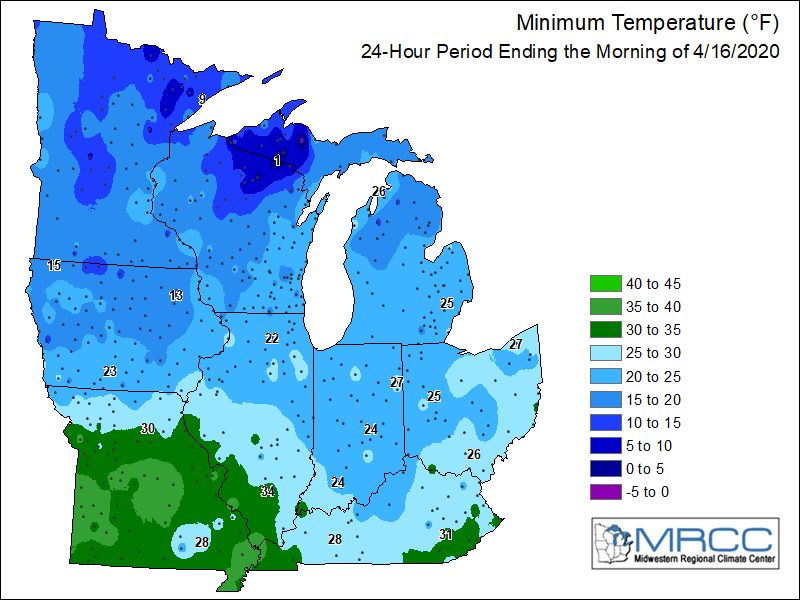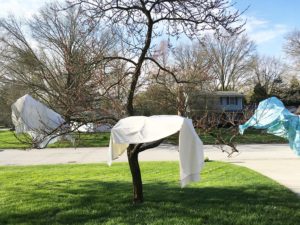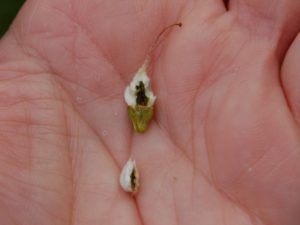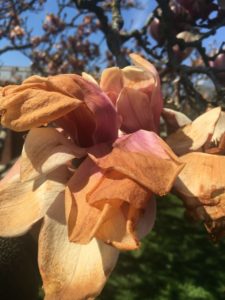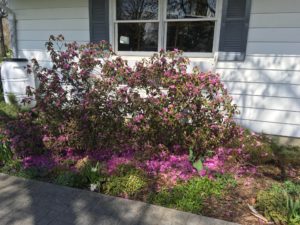As so many gardeners are staying at home these days, we’ve had more opportunity to enjoy the spring display. And then, perhaps inevitably, “normal” spring frost and freeze visited – some plants are vulnerable to damage. The amount of damage will depend on how far along they are in their development.
Home fruit-growers may have reason to be concerned: At 28 F, you can expect a 10 percent loss of flowers/young developing fruit. However, at 25 F that loss increases to 90 percent! Much of Indiana dropped to the mid 20’s on the mornings of April 15 and 16. (Fig. 1)
- Figure 1: Temperatures across the region the morning of April 16, 2020. Credit: Midwest Climate Watch, Midwestern Regional Climate Center https://mrcc.illinois.edu/cliwatch/DLY_LT_MAPS.htm#
For home growers, covering plants with sheets or blankets might provide a few degrees of protection. (Fig. 2)
- Figure 2. Covering trees with sheets or blankets can provide a few degrees of protection. Credit: John Obermeyer, Purdue Extension
Bud counts were good until the freeze, so in some cases, even just 10 percent retained fruit might still be a decent crop on our tree fruits. Grapes may also still have ability to crop on shoots that have yet to emerge. Strawberries are a bit easier to protect through frost and freeze, but only if you took measures, such as using floating row covers, recovering with straw, etc.
However, it is only mid-April and additional frosts/freezes are still possible. Bottom line is that unless it is already a complete loss, we won’t really know the rest of the story for quite a few more weeks.
It is easy to check fruit buds for damage by cutting open the bud and looking for dark brown or black centers. (Fig. 3)
- Figure 3. Freeze damaged young peach fruit. Credit: Bruce Bordelon, Purdue Extension
Our Purdue Extension fruit specialists put together these videos to help you assess the status of your fruit plants.
Assessing Spring Freeze Damage to Apples
Video: http://youtu.be/YcSRg74Hb_A
Assessing Spring Freeze Damage to Peaches
Video: http://youtu.be/DcS2XGAqoFk
Assessing Spring Freeze Damage to Grapes
Video: http://youtu.be/lNUZu5Bx08M
Assessing Spring Freeze Damage to Strawberries
Video: http://youtu.be/F-QoX1C4_S0
Assessing Spring Freeze Damage to Blackberries
Video: http://youtu.be/EyIhvfY2apM
For ornamental trees and shrubs, plant response has been quite varied, depending on species, location and, of course, temperature and duration of that temperature. Susceptible plants may have wilted leaves, brown or black necrotic spots on leaves, or perhaps dieback of entire twigs. Plants that were in bloom likely have brown petals or dropped flowers entirely. (Figs. 4 and 5)
- Figure 4. Magnolia blossom with severe freeze injury. Credit: Bruce Bordelon, Purdue Extension
- Figure 5: Rhododendron blossom drop due to freeze. Credit: John Obermeyer, Purdue Extension
Note that freeze incidents are normal for this time of year. The good news is that woody plants, in most cases, will outgrow the damage.
